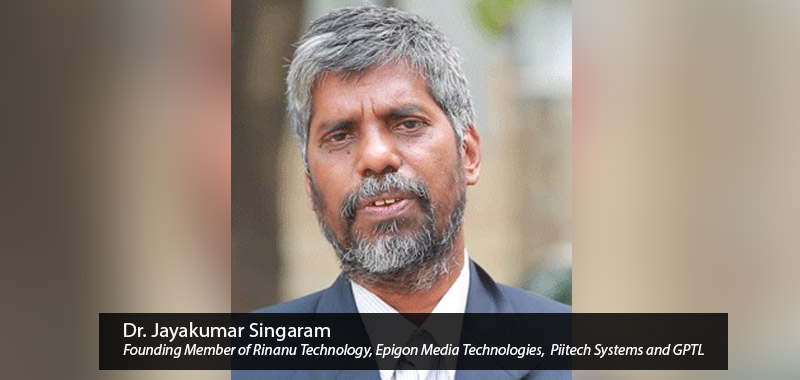
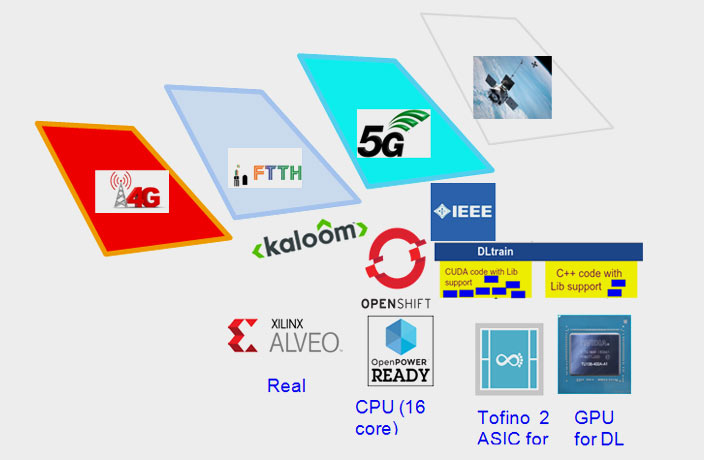
Network Application containers from Kaloom and IEEE 1451 team run on Openshift with support from OpenPower CPU and Tofino 2. Satellite broadband is emerging to support IoT across the globe. 5G provisioned mMTC (massive Machine Type Communications) and Low latency for IoT events. 4G is trying to keep VM in business but Openshift is using Container technology and Kubernetes to emerge as a modern platform in Edge-Native Cloud and also in Core/ Center Cloud. Fiber to the Home might become Fiber to the Edge. IEEE1451 provides an amazing framework for a huge number of smart sensors to work towards an objective which is defined in the Application layer in Edge-Native Cloud. Kaloom provides Network applications that help Edge-native applications handle the Communication part efficiently.
Digital Platform based services require complex infrastructure that includes Sense, Communicate, Compute, Store, and Share results. IoT applications with cameras as sensing elements generate good amounts of data. 5G provides a fast communication link such that applications can access sensor data and communicate results to those subscribed to the same service within the order of 10’s of milli seconds or less.
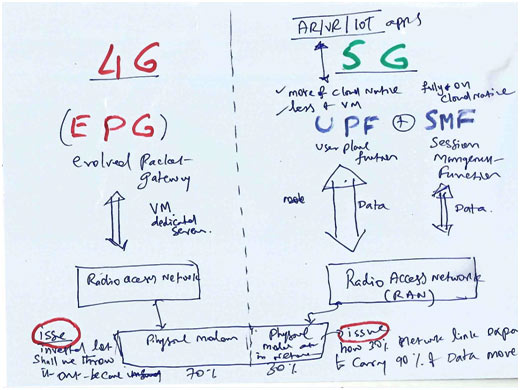
In the above figure, details on 4G and 5G based link service for application is illustrated. Evolved Packet Data (EPG) is the core of data links which are used by applications. In 5G, User Plane Function (UPF) and Session Management Functions (SMF) together provide required functions for Data to Applications. It appears that 5G provides 100 times more data rate compared to 4G networks. In 4G, Release 13 (R 13) onwards there is support for narrow band IoT. However, that appears to be good for sensor networks that generate data in the order of kilobytes per second. Moreover, there is no commitment from network on network delay during data travel from sensor to application. There has been an option to deploy intelligence along with sensors such that inference will travel to Applications instead of full data.
2. IoT enabled Service Delayed by 4G?
EPG service is carried out by using Virtual Machine (VM) or dedicated Bare metal server. Setting up a given VM will take in the order of seconds time taken to create a VM depends on the steps involved and time you take to fill in the options…On an avg when you fill the details and click on finish on the last step is should not take more than 30 secs…15 secs on an average…..similarly powering on a vm etc takes almost 30 sec to 60 sec depending on the hardware. After setting up VM then there is a need to deploy applications and that also might take an equal amount or more to download all dependencies from the web and make VM to handle EPG traffic. The mentioned setup time of VM is insignificant if EPG continues to use VM for an hour or more for given application data transportation. In case, data time itself is for 10 seconds or less (which is a normal case in IoT) then the above mentioned setup time is not good for application. Moreover, it may not result in good business sense as well. But for non-IoT applications such as Movie download and browsing, the above time for setup will not create any issues.
3. IoT Data Handling in 5G
In 5G, it is recommended to have Cloud Native application to handle UPF which is high bit rate data traffic. Data traffic in SMF might be low bitrate and thus it is not an issue in handling the same. Deploy a container image on an OpenShift cluster to make the application easier to manage, scale, connect and monitor.
Shifting from virtual machines to Docker containers allows developers to deliver changes in a fraction of the time. And once an app is in a container, it’s portable. So the team can move it freely from any Cloud service providers. Kaloom provides switch fabric to handle UPF in real-time. Moreover, three is provision to program Kaloom fabric for a given data traffic in UPF. Thus time required to start serving UPF tatta traffic in the order of sub millisecond.
IoT applications will benefit from Kaloom fabric to handle data traffic in UPF. Moreover, to handle SMF, there is no need to have a separate controller. In Kaloom fabric SMF is also done by scripting. Thus there is a possibility to handle IoT data traffic in real time and applications continue to provide service in real time.
Kaloom platform includes its software-defined fabric (SDF), virtual router (vRouter), virtual switch (vSwitch), and virtual gateway (vGW). The platform sits between orchestration, an SDN controller, or a spine controller and the application servers or storage servers in a data center. It offloads data plane functions from virtual machines (VMs) and containers to gain throughput and reduce latency. zero-touch provisioning of the virtual network and components is able to reduce set-up time from several days to minutes. This also allows for the network components to receive automatic updates during runtime.
4. IoT Edge Configuration
End to End (E2E) service creation and management the same till end of created E2E service. Mentioned E2E services include the following sub systems to handle full workflow that are linked with IoT Sensors, IoT Edge at one side and other side with Cloud native applications that run in Cloud.
Even further the journey of innovation (in a train called DLtrain) that had full focus on “ Computation on your Table”, had led to a way to handle “Data and AI” such that your application can keep growing as you start implementing and imagining more and more . For example, “Cloud in Box” is taking shape as “Cloud on your table” by using innovations in using native Tool chains to build and deploy applications to handle “your Data and your AI”. More over mentioned “On your Table’ infrastructure provides to work with your team and your ideas at a given point of time with full speed in your thought process and also with your available resources usage at maximum.
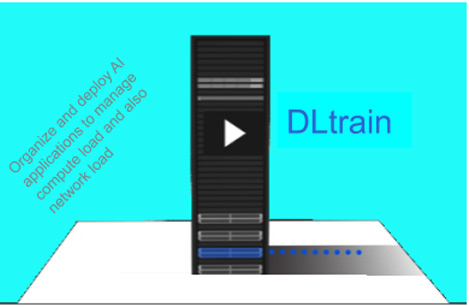
The OA (Thanks to Object Automation) team started deploying DLtrain on the above-mentioned system from Raptor. Loading Ubuntu 18.04 went well with support from inside team members of OA. But then, there is a need to use CUDA core (GPU) as well along with OpenPower such that “accelerated training is possible for given workloads from Deep learning network training”. To create a powerful IoT Edge, addition of GeForce RTX 207 also came to Lab and added to existing OpenPower Motherboard with PCI interface. Addition of PCI add-on hardware GeForce RTX 2070 had given another challenge to get the correct driver from Nvidia. Team in OA is experienced in handling hardware and associated complexity, and the same enabled team to get a working version of driver for RTX 2070 hardware which is in PCI bus. Appears that there is an issue in the Display driver in Ubuntu 18.04 and Driver for RTX 2070 from CUDA 10.1 SDK. Again, the team in OA had reached the community for advice and support. Hint is to Disable Nouveau and try the installation process again. Team in OA, used Reference Link 3 and continued the process of disabling Nouveau.
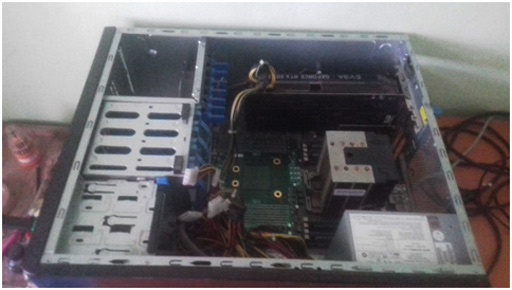
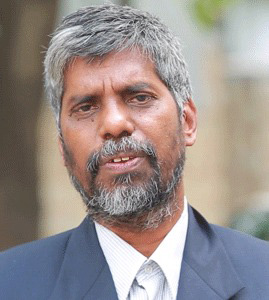
Dr. Jayakumar Singaram is a founding member of Rinanu Semiconductors, Epigon Media Technologies, PiiTech Systems and GPTL. Dr. Jayakumar is also an alumnus of IIT Bombay and has been on the forefront of the emerging trends in embedded systems and IOT, having worked with organizations like HAL (Helicopter Design Bureau), Cranes InfoTech, Mistral Solutions and Essel Utilities and some significant others over a career spanning across two decades. He has worked on key projects such as design and development of the Karaoke Machine (a project in collaboration with Analog Devices and MIT Media Lab) for TAITO Corp. He also worked on Satellite Radio Receiver for WorldSpace broadcast Satellites (and DAB Radio Receivers), using low-cost Digital Signal Processors.